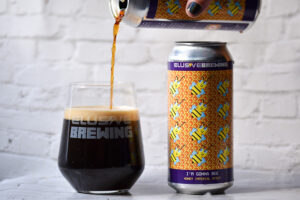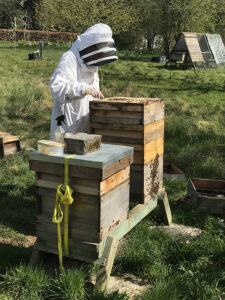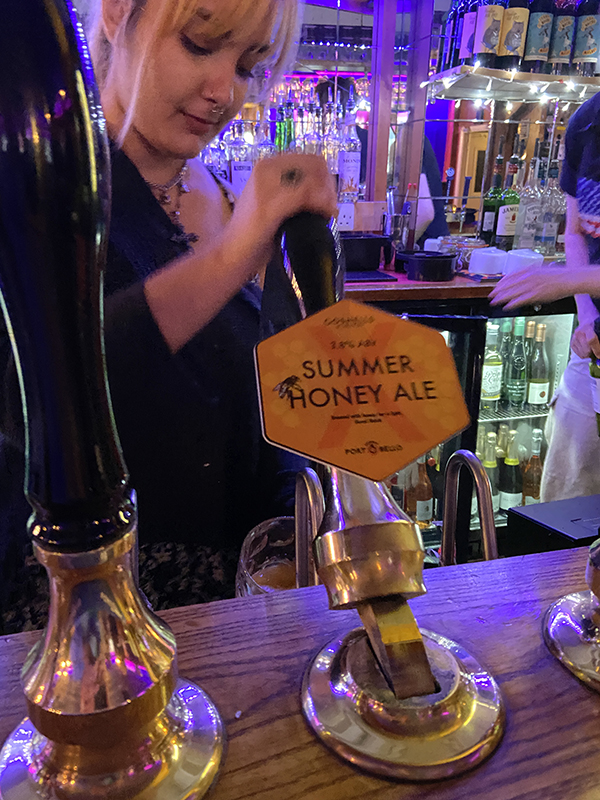Before there was beer, there was mead. At least, that’s the theory. While archaeological evidence suggests beer predates drinks such as wine and cider as homo sapiens’ recreational beverage of choice, our ancestors may well have been dipping enthusiastically into spontaneously fermented honey from the wild beehives in primeval forests well before they brewed beer.
Availability was helped by the relative ease with which honey ferments. Ambient yeasts stumbling across it will go to town, converting most of the sugar to alcohol. This would have made hunter-gathers familiar with its effects, and even today, producers need to ensure their honey is sealed and stored properly to prevent unwanted fermentation.
Planned fermentation is another matter. Mead itself is fermented from honey in the way wine is from grapes or cider from apples. Mead also has variants such as metheglin, where herbs or spices are added, and melomel, with fruit added. Somewhere between mead and beer is braggot, a drink made with roughly equal amounts of honey and malt.
For more than a decade, the British Guild of Beer Writers has sent a delegation of judges to the National Honey Show, where there are categories for both commercial and home-brewed honey beer. This is a task BEER editor Tim Hampson and I have embraced with such enthusiasm, our duties have extended to the braggot category.
Sadly, our view of the esteem in which we hope the nation’s top beekeepers hold us was slightly dented at the 2022 event, when the steward allocated to facilitate our deliberations, who was admittedly a tad hard of hearing, insisted on calling us Tom and Jim throughout. However, we intend to press on.
Berkshire’s Elusive Brewery, has won the commercial brewing category at the show two years running. In 2021, its winner was Bee Strong, a 10% ABV barrel-aged Scottish wee heavy style beer. In 2022, 11% ABV imperial stout I’m Gonna Bee won Gold, and also had the distinction of being Elusive’s 500th brew at its Finchampstead site.
The higher strength of the two winning honey beers is no coincidence, says Andy Parker, founder and head brewer at Elusive. With the honey character too dominant in earlier attempts, “we now try to brew a robust beer to put up against the honey flavour,” he says. “You need a beer style that’s not going to just let the honey overpower it.“

Andy expands: “We’d tried brewing in the past using cheaper honey, which might be diluted or have sugar added, and never had much success with it. The yeast just chomps through the sugar and you get nothing left at the end.
“The challenge for us as a brewer is to keep the honey flavour in the beer, and it wasn’t until we started using proper, artisanal honey that we started to get that real flavour coming through.
“We avoid boiling the honey, although we do need to pasteurise it, because it contains all kinds of organisms. We use it as an ingredient in the wort boil, adding it at a lower temperature after the boil. We then transfer it to the fermenter, with the hope that plenty of the flavour and residual sweetness will be left behind.”
The honey for both of Elusive’s winning beers was supplied by a Reading-based beekeeper Claire O’Brien. “There are very different flavours based on the flowers the bees feed on, and for the imperial stout in 2022, we used a range of honeys to brew the beer,” says Andy.
In terms of customer appeal, “we do find there’s more interest in the fact that it’s a honey beer, and that’s partly because Claire will share the news on her social media. Her followers, who are into honey and beekeeping, will seek it out, and that opens up a new market for us. On the flip side, our usual customers try it, and might decide that they also like honey beers.”
As well as keeping bees as a hobby, Claire O’Brien home brews a saison-style beer, makes mead, and is “a very keen supporter of local breweries”. Aptly, Claire met Andy Parker in the tap room of Reading’s Double-Barrelled Brewery, which had used some of her honey to make a beer. “Now, I take Andy some honey once a year,” she says.
Like most English honey, Claire’s is multi-floral, meaning the beers take pollen from a range of plants, “and you get a really different flavour from month to month.” She keeps apiaries in her own suburban garden, as well as on an allotment, and further out into the West Berkshire countryside, which all adds to the flavour variety.
The average annual yield from each hive is around 20kg. At either end of the scale, there can be years where there is no surplus honey beyond what the bees need to survive, while a bumper year might see a yield of 60 to 80kg of honey. “It depends on the weather, and the flowers.” The dry summer of 2022 gave the bees maximum daylight hours to forage, and so was “stupendous” in terms of yield.
Claire’s advice to anyone brewing with honey is to use the best quality available. “There’s a misconception that you can use lower quality honey in cooking, baking or brewing. but it’s tricky to make the honey flavour come through because of the process, and the other strong flavours you’re using. You need your best flavoured honey, so those characteristics are bought to the front.”

Second prize in the Commercial Beer category at the 2022 National Honey Show went to Knocking on Pollen’s Door, a 6.2% saison-style bière de miel brewed as a collaboration between the Halifax Beekeepers Association and Manchester’s Runaway Brewery. The project was facilitated by Brew Wild, an organisation set up to protect and create bee habitats by bringing together beekeepers, brewers and gardeners.
Made with honey donated by beekeepers from around the Calder Valley, the beer used a slow-fermenting Belgian yeast to retain as much of the floral character of the honey as possible. Mark Welsby, co-founder and head brewer at the Runaway Brewery, said: “We’ve worked with Brew Wild a few times over the years. They’ve put us in touch with various beekeepers, across Greater Manchester. and this time in the Calder Valley.”
Mark is now a convert to honey beer, but has taken a while to embrace the style. “I was dubious at first, because I’ve found honey beers to be very up and down. From a flavour perspective, what does honey actually add to beer? So, it wasn’t so much the thought of working with honey itself, as the idea of the project, promoting habitat, environment and sustainability, that appealed initially.”
In addition, “we do plenty of collaborations, but very rarely with other brewers. From our perspective we enjoy working with people who look at flavour in a completely different way to us, such as chefs, bakers – and now beekeepers.”
Having found that a vigorous fermentation when brewing with honey can mean losing the delicate aromas, Mark used the slower yeast strain to achieve the bière de miel style for Knocking on Pollen’s Door, without needing to make it a very strong beer. “We’ve had a really good response. The localism aspect helps a lot, especially as a story to help trade customers promote the beer.”
Richard Searle of Brew Wild said: “Some brewers can be put off by the price of honey, but I think our model can be replicated – the honey donated was paid back in beer.”
Another former winner at the National Honey Show is Fuller’s Honey Organic Dew. The 5% ABV golden ale is brewed and bottled year-round at the Asahi UK-owned Griffin Brewery in Chiswick, and has a national listing on the drinks menu a Pizza Express restaurants
Head brewer Guy Stewart ‘inherited’ Honey Dew when he took on the role. He says: “It’s a 520hl brew, and we add 1.2 tonnes of honey in the copper, pre-boil, and then when we filter the beer we add an extra 50 kilos. I definitely think it’s that extra honey we add in at the end that ensures the beer maintains its honey notes.”
Fuller’s uses organic honey from Brazil to brew Honey Dew, which also has the advantage of being consistent from batch-to-batch. Heated jackets on the storage tanks keep the beer warm enough to prevent the honey setting. “If it does get thick, it’s very difficult to pump, and it’s even worse if it crystalises.”
Which might raise the question of why a large commercial brewer would work with a potentially challenging ingredient, but Stewart believes both the honey flavour and aroma, as well as the organic credentials of the beer, add a point of difference. “It’s an ale that’s not too ale-y, a light beer but not a lager, and with a slightly sweeter character.”
Another previous winner in the National Honey Show commercial category is Oxfordshire brewer Lovibond, whose 7.3% ABV Gold Reserve ‘Wheat Wine’ fell somewhere between a wheat beer and a barley wine. Founder Jeff Rosenmeier agrees brewing with honey “can be tricky. We’ve brewed this several times and one major learning was when to add the honey in the process.
“Typically, an adjunct would be added just at the end of the boil in order to pasteurise it. When we did this, we found that the yeast would happily consume the sugar from the honey, but then stalled when it got to the more complex malt sugars. It finished far from our expected final gravity, giving us a heavy, sickly sweet beer.
“We changed the process to adding the honey in the fermenter. The yeast happily finished the job on the simpler sugars, leaving us with a drier and less overly sweet beer.”
Tom Gosnell, founder of London meadery Gosnells, sees plenty of common ground between brewers, mead makers and beekeepers within the wider craft food and drink movement. “It’s great to work with people with a shared ethos, and learn different things,” he says.
In Summer 2022, a collaboration between Gosnells and West London’s Portobello Brewing saw the creation of the 3.8% ABV Gosnell’s Summer Honey Ale. “We‘ve made a few cask braggots in the past. combining cereals and more than 50% honey,” says Tom. “They’ve been serious winter warmers of around 6% abv, but for this collab, we wanted to make something a little lighter and brighter for the summer, a gently chilled mild blonde.
“Honey has an amazing ability to be both floral and fruity and, when combined with the right malt and hop bill, you can get the best of both worlds.”
This article originally appeared in BEER magazine
